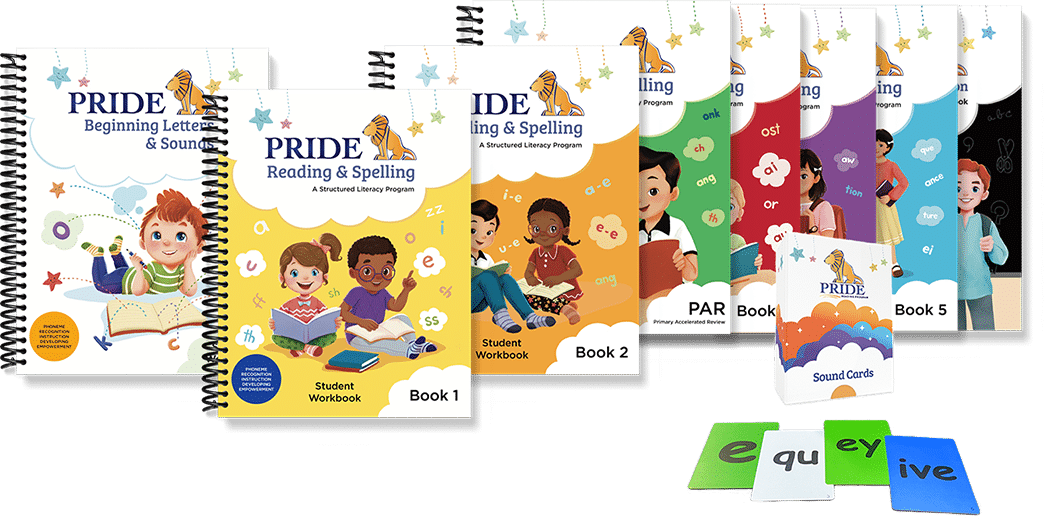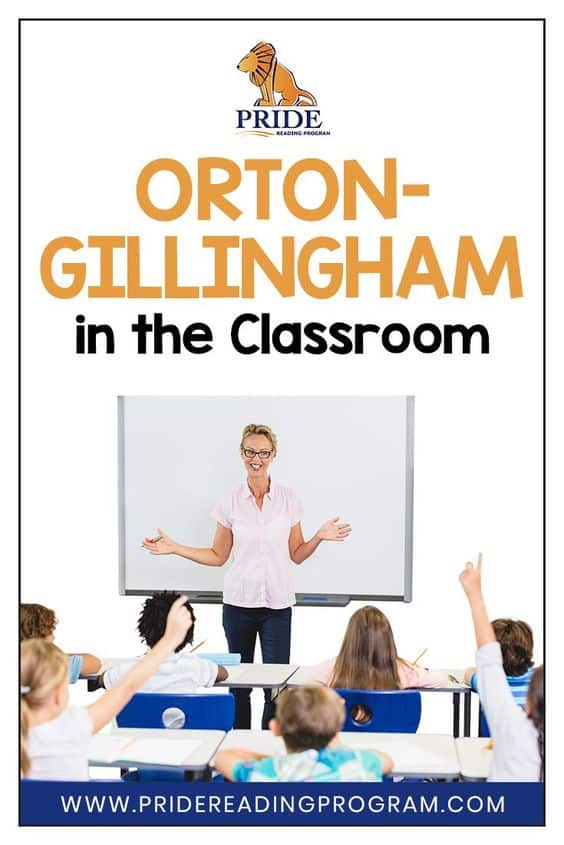Are you thinking about using the Orton-Gillingham method in your classroom? Although Orton-Gillingham is intended to be used 1:1 or in small groups, it is quite possible to teach it in a classroom setting. Bringing the Orton-Gillingham approach into a classroom benefits all students, but for those who are struggling, this method is a huge plus! Here are some classroom teacher tips on how to set up the Orton-Gillingham classroom with whole-classroom instruction, literacy centers, and small-group instruction so that all students in the classroom will benefit from this amazing approach.
How Do You Teach Orton-Gillingham with Whole Classroom Instruction?
A structured literacy program, such as the Orton-Gillingham approach, works well with general classroom teachers, reading specialists, and special education educators. Various aspects of the method can be introduced into any curriculum or classroom with students of all ages. The Orton-Gillingham approach is flexible and can be adapted over time in any classroom, especially during whole-classroom instruction.
During whole classroom instruction, the teacher can review the phonograms, spelling rules, and syllable types using anchor charts and teacher/class interaction. The teacher can also include a quick review of already learned concepts. This is an ideal time to practice:
- Daily Sound Card Review
- Introduction of a New Concept (picture page, keyword)
- Phonological and Phonemic Awareness Activities
The whole class instruction can take 5-10 minutes.
How Do You Set Up Literacy Stations in the Orton-Gillingham Classroom?
Because the heart of the work that needs to be done in the Orton-Gillingham classroom is during small group instruction, the teacher can utilize rotating classroom literacy centers so that students can work independently or with partners while the teacher is delivering explicit instruction with a small group elsewhere in the classroom.
These centers are basically stations where students can spend valuable time interacting and practicing a concept the teacher has introduced during whole classroom instruction. Depending on how many students are in the classroom, the teacher can set up 3-5 stations around the classroom. The students will rotate from station to station. The goal of the literacy center is to provide students with meaningful independent reading practice.
The structure and routine will stay the same at each station throughout the year – only the concept that is being taught will change from week to week. There will be times when stations can be set up for two weeks depending on the difficulty of the concept that is being taught. Each station can be set up as:
Station 1 – Red Words
This station will include Red Word (sight word) work. The students can use sand trays to spell a list of words, or trace sight words with crayons on a bumpy surface. They can also have sight word flashcards, and practice together with partners. Memory game sight words or bingo games with the group works well here too. Each week the teacher will post a new list of sight words for the students to practice.
Station 2 – Letter Tiles
This station will include letter tiles and word-building activities for the students. The teacher can have a list of words displayed with the target concept and the students can build the words with their letter tiles. Students can also pair up and take turns dictating the words to each other and building them.
It is easiest if the teacher has the letter tiles set up on a magnet board or on a cookie sheet. Teachers can also have individual baggies of letter tiles for each student in the group. Students can take turns building words individually or with partners.
Station 3 – Fluency Practice
This station will include Fluency Practice. The teacher can place some reading trackers or reading markers at the station along with the Fluency Practice/Drills that the students need to practice. The teacher can also have the students partner together and read through the fluency sheets with each other. Having stickers or stamps on the table makes it more motivating and the students can give each other stickers as a reward. The PRIDE Reading Program Fluency Practices have one practice per concept. These can be utilized for the entire week.
Station 4 – Games
This station will include playing a game with the concept that the student is practicing. These games can be word sorts, word searches, dice games, etc. These games can be played with partners or as a whole group. The PRIDE Reading Program Games are included in the back of the Student Workbook. There is one game per concept and can be utilized all week.
Other Options:
- Read to Self
- Listen to Reading
- Self-directed journal writing
- Word Work
- Computer online learning
How do you Teach Orton-Gillingham in a Small Group Setting?
Whole classroom reading lessons can often be too challenging for struggling readers and not always meet the student’s needs. A small-group approach, on the other hand, can meet the needs of each student through differentiated instruction as well as matching the instruction to each student’s level. (Amendum, et al., 2009). Beginning readers benefit the most from being taught the Orton-Gillingham approach through explicit and direct reading instruction during intensive, small-group instruction. A small group of 3-4 students enables the classroom teacher to focus on specific skills needed by varied groups of children (Tyner, 2003).
Differentiated small group Orton-Gillingham reading instruction is done by matching the instruction with the needs of the learner (Kosanovich, Ladinsky, Nelson, & Torgesen, 2007). Through small group instruction, the classroom teacher will deliver teacher-led explicit Orton-Gillingham instruction. This reading instruction might include:
- Dictation of Sounds, Words, Sentences
- Reading of Words, Sentences, and Decodable Text
- Decoding and Comprehension Strategies
- Systematic word study
- Sky Writing, Blending Drill, and Sound Segmentation
- Vocabulary
- Writing
- Assessment and Observations
How Do You Group the Students by Level in Orton-Gillingham?
The teacher can begin by giving each individual student in the classroom an initial Orton-Gillingham assessment, and then grouping the students by skill level. Teachers can use this Placement Assessment to determine which level is best to start the students(s):
>PRIDE Reading Program Placement<
How Do You Schedule and Pace Students in Orton-Gillingham?
For students to make the maximum amount of progress in a small group, it is recommended that the student receives an uninterrupted 20 minutes of instruction five days a week. Teachers should not feel like they have to push through an entire lesson in one sitting. If a group needs more time with an individual step in the program the teacher can simply mark the place and then next time start off with a quick Sound Card review and then pick up where the group left off.
Some concepts may take a week or more to complete. A number of variables including the student’s age, attention span, and the difficulty of the concept being taught will play a part in how quickly a skill will be learned. It is very important not to modify the lessons but teach them with fidelity. The goal is for the student to work through the lessons step-by-step slowly and carefully and close all reading and spelling gaps.
There are certain elements of the Orton-Gillingham lesson plan that will be repeated each day. Components like the Sound Card Review, the Phonological Awareness activities, and the dictation are essential, especially for struggling readers. For teachers using the PRIDE Reading Program, they need to follow the script step-by-step in their small-group instruction.
The flow of the classroom will take some classroom management from the teacher. It is advised that at the beginning of the school year, the teacher guides the students through the rotation process, including expectations, management systems, and reward incentives.
I Have a Resource for You!
Thank you for reading this post today. You might also enjoy reading my previous posts:
How to Use Token Economy To Manage Behavior
Show me an Orton-Gillingham Lesson
The Science of Reading: What All Teachers Should Know
Please don’t leave without checking out the PRIDE Reading Program. The PRIDE Reading Program is an Orton-Gillingham curriculum, aligned with the Science of Reading, that is used by teachers, tutors, and homeschooling parents worldwide with great success.


Karina Richland, M.A., is the author of the PRIDE Reading Program, a multisensory Orton-Gillingham reading, writing, and comprehension curriculum that is available worldwide for parents, tutors, teachers, and homeschoolers of struggling readers. Karina has an extensive background in working with students of all ages and various learning modalities. She has spent many years researching learning differences and differentiated teaching practices. You can reach her by email at info@pridereadingprogram.com or visit the website at www.pridereadingprogram.com


